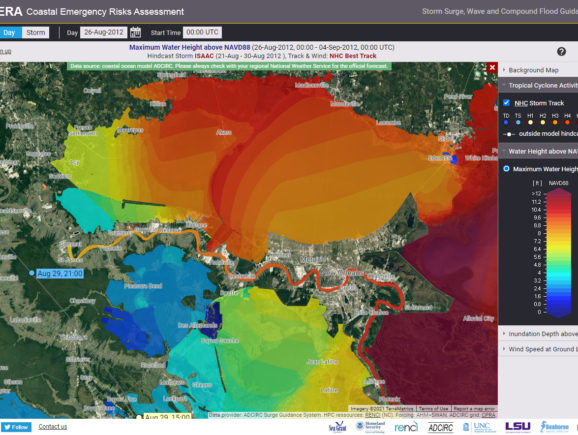When Every Minute Counts: Flood Inundation Modeling and Mapping
Third in a series; see more under Related Articles below.
During a hurricane or tropical storm, one of the biggest threats to communities is compound flooding from storm surge and precipitation. Forecasting storm surge and riverine flooding in real time, however, is incredibly challenging — especially along in Louisiana’s complex coast. Our multidiscipline team is addressing this challenge by providing Louisiana’s decision-makers with flood guidance in real time. With a 15-year track record of proven success, our team deploys supercomputer-powered models to rapidly inform critical decisions at a large scale.

Freese and Nichols’ Stormwater team is supporting efforts to predict compound flooding through real-time flood inundation modeling and mapping.
Our hydraulic and hydrologic modeling improved decision support, emergency response and post-disaster recovery through the Compound Flood Inundation Guidance System (CFIGS) developed for the Louisiana Coastal Protection and Restoration Authority (CPRA). Our team developed a 2-D HEC-RAS model building upon the U.S. Army Corps of Engineers’ (USACE) existing Lake Pontchartrain and Lake Maurepas Regional Model.
The project provides information on timing, duration and extent of compound flooding while including provisions to address the uncertainties in flood inundation forecasting throughout the Lake Pontchartrain/Lake Maurepas watershed. The updated model increases the predictive capabilities for use in dynamic flood inundation mapping and improves the forecast reliability. The inundation products are exported to the Coastal Emergency Risks Assessment (CERA) web application for improved decision support during inclement weather.
The updated model represents existing conditions to the greatest extent possible by incorporating major drainage features, inline structures, and variations in roughness based on latest land use data. We calibrated and validated the model to available gauge data and improved model stability by executing the model through a range of frequent, moderate, and extreme events. Model results were validated against known inundation extents and high-water-mark data gathered by the U.S. Geological Survey/National Oceanic Atmospheric Administration.
About Our Team
At the heart of this work is the decision support tool developed and coded by senior hydrologist Katelyn Costanza, PE, CFM, the owner of CE Hydro, LLC, a Louisiana-founded woman-owned small business. Robert Twilley, at Louisiana Sea Grant, has been a key collaborator and supporter of this effort. Highly specialized hydraulic modeling resources from Freese and Nichols, led by Jim Keith, PE, CFM, and Bethany Fleitman, PE, CFM, have provided riverine modeling support to update, calibrate and validate a 2D model of the Lake Pontchartrain and Lake Maurepas watersheds. In addition, team member Jason Fleming, Principal of Seahorse Coastal Consulting, is the lead of the real-time ADCIRC Surge Guidance System (ASGS) for Louisiana and integrates critical surge data, while Carola Kaiser at the LSU Center for Computation and Technology led the development of visualization tools for the real-time forecasts on the Coastal Emergency Risks Assessment (CERA) website. The work is being done for the Louisiana Coastal Protection and Restoration Authority (CPRA) and Louisiana Sea Grant.
Read more from the LSU Office of Research & Economic Development: Partnerships Improve Hurricane Storm Surge Forecasts for Louisiana, Nation



